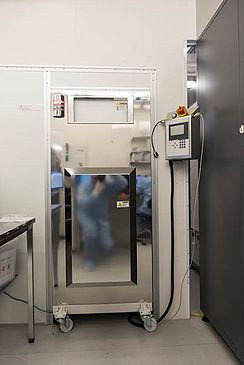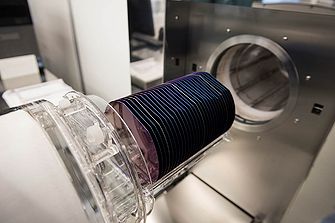Specific Process Knowledge/Thermal Process/Resist Pyrolysis furnace
Feedback to this page: click here
This page is written by DTU Nanolab internal
The Resist Pyrolysis furnace (research tool)
From February 2024: The name of the furnace has changed from "Multipurpose Anneal furnace" to "Resist Pyrolysis furnace" (or “Furnace: Resist Pyrolysis” in LabManager). At the same time, the furnace has become a research tool. This means, that the furnace is mainly available for users working on certain research projects at DTU Nanolab, and it should mainly be used for resist pyrolysis
The Resist Pyrolysis furnace it made by ATV Technologie, and it was installed in the cleanroom in 2015.
The furnace is mainly being used for resist pyrolysis. It can also be used for annealing in nitrogen (N2) and oxidation with oxygen (O2), but O2 is mostly used for cleaning of the furnace after resist pyrolysis.
Process steps can run either in vacuum or at atmospheric pressure. A small N2 or O2 flow (up to 2 slm) can be applied in vacuum steps.
The quartz parts in the furnace can be changed, depending on what processes and samples the furnace is used for, but it has been decided that a quartz set for resist resist pyrolysis will be mounted in the furnace all the time. This limits the number of materials that are allowed in the furnace.
All process gases (except purge nitrogen) are heated, before they are introduced into the furnace at the door side.
The furnace tube is heated by use of 12 long heaters situated along the furnace tube and combined in three groups (top, bottom left and bottom right) and two flat heaters situated in the ends of the furnace tube. The this way the temperature will be very uniform everywhere in the furnace tube. However, the front heater is unfortunately broken at the moment. The heating can be done very fast, up to 30 oC/min. The maximum allowed processing time and temperature is 3 hours at 1050 oC.
The furnace body surrounding the furnace tube consists of a top and bottom half-shell. To cool down the furnace (when the temperature is below 800 oC), the top half shelf can be lifted up, and cooling fans will then flow air from the surroundings around the furnace tube to cool it down.
It is not possible to open the furnace, when the temperature is above 300 oC.
For resist pyrolysis, samples with different resist layers are heated up to maximum 1050 oC in a nitrogen atmosphere. At high temperatures carbon is formed by pyrolysis of the resist. In this way conductive structures can be made from a resist patterned sample. If oxygen from the air or from outgassing of the resist is present in the furnace, the resist layer will be removed, thus it is important to evacuate the furnace and flush it with nitrogen, before a high temperature for resist pyrolysis is obtained. Pyrolysis of a large amount of resist may also be a problem due to resist outgassing.
The user manual, technical information and contact information can be found in LabManager:
Process information
- Results from the Resist Pyrolysis (former Multipurpose Anneal) furnace acceptance test
- Resist pyrolysis
- Annealing: look at the Annealing page
- Oxidation: look at the Oxidation page
| Purpose | Processes |
|
|---|---|---|
| Performance | Film thickness |
|
| Process parameter range | Process temperature |
|
| Process pressure |
| |
| Gasses on the system |
| |
| Substrates | Batch size |
|
| Substrate materials allowed |
|

